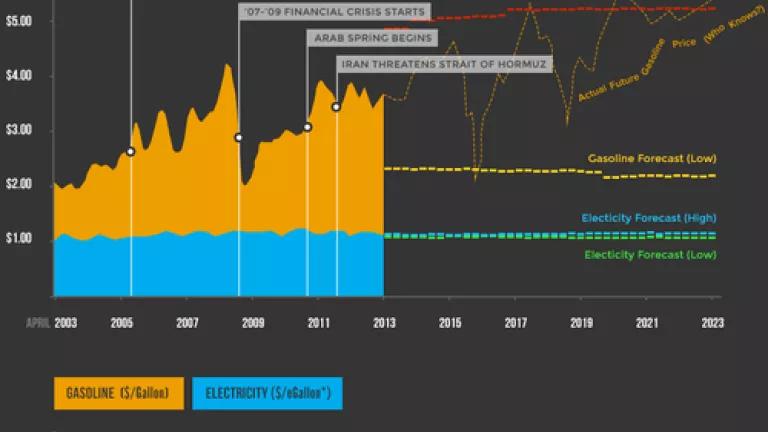
Today, NRDC joins a diverse coalition of community, health, and environmental groups to launch the Charge Ahead California campaign to deploy one million electric cars, trucks, and buses in the state within ten years. The campaign includes the American Lung Association in California, CALPIRG, Coalition for Clean Air, Communities for a Better Environment, Environment California Research & Policy Center, The Greenlining Institute, Sierra Club California, and the Union of Concerned Scientists. The campaign’s goal marks an important milestone on our path towards a zero emission vehicle fleet needed to meet California’s long-term climate goals, federal air quality standards, and to provide all Californians with much needed relief from volatile petroleum fuel prices.
The average household spends $2,756 on gasoline and motor oil annually, straining family budgets and hitting lower income households especially hard. Our campaign aims to provide some relief; driving an electric car is the cost equivalent of driving a conventional vehicle on dollar-a-gallon gasoline.
In addition to being three times cheaper than gasoline, electricity prices are also much more stable. The chart below contrasts the historical and forecasted prices of U.S. gasoline and residential electricity in dollars per gallon equivalent, adjusted for inflation.
The wild fluctuations in the price of a gallon of gasoline make it painfully obvious that no one regulates the world oil market. Likewise, the huge disparity between the Energy Information Agency’s high and low gasoline forecasts underscores the risk inherent in perpetuating our dependence on oil. In contrast, the price of electricity follows a predictable seasonal pattern, never deviating far from the buck-a-gallon equivalent mark. Even better, there’s virtually no difference between the high and low forecasted electricity prices, with both sticking right at the dollar-a-gallon mark. The price of electricity is more stable because electricity is made from a diverse supply of largely domestic resources and is carefully regulated by state public utility commissions. Electricity is also coming increasing from renewable resources with low marginal operating costs; sunshine and wind are free.
The Charge Ahead California campaign officially launches at the historic Los Angeles County – USC Medical Center at Boyle Heights, a facility that has been dealing with the consequences of dirty air even before the city health department established its Bureau of Smoke Control in 1945, paving the way for what eventually became the federal Clean Air Act.
Thanks to California’s precedent-setting policies, the days when smog blankets Los Angeles are far less frequent and severe. However, the American Lung Association’s 2013 “State of the Air” report shows that California still has seven of the top ten most polluted cities in the country. Four in ten Californians, more than in any other state, live close enough to a freeway or busy road that they may be at increased risk of asthma, cancer and other health hazards. Nearly twice as many Californians die from traffic pollution as from motor vehicle accidents each year.[1]
The social and economic damage associated with air pollution from vehicles is pervasive, but solutions are all around us. More than 50,000 Californians have made the decision to drive electric cars —significantly reducing global warming pollution and improving local air quality. According to estimates by the American Lung Association, a 100 percent electric fleet in California running on electricity that is one-third renewable would avoid: $13 billion in health, climate, and other societal damages annually, 10,000 asthma attacks every year and 275 tons of criteria pollutants every day.
Our diverse coalition campaign aims to ensure all Californians have access to cleaner air and a cleaner fuel that will provide much needed relief from pain at the pump. Please join us in realizing this vision.
************************************
[1] 5,726 annual premature deaths in California due to PM 2.5 and 209 from ozone (Fabio Caiazzo et al., Air pollution and early deaths in the United States, Atmospheric Environment, 2013) compared to 3,081 traffic fatalities (Selected Detail Within Leading Causes Of Death By Sex And Race/Ethnic, California Department of Public Health.)



